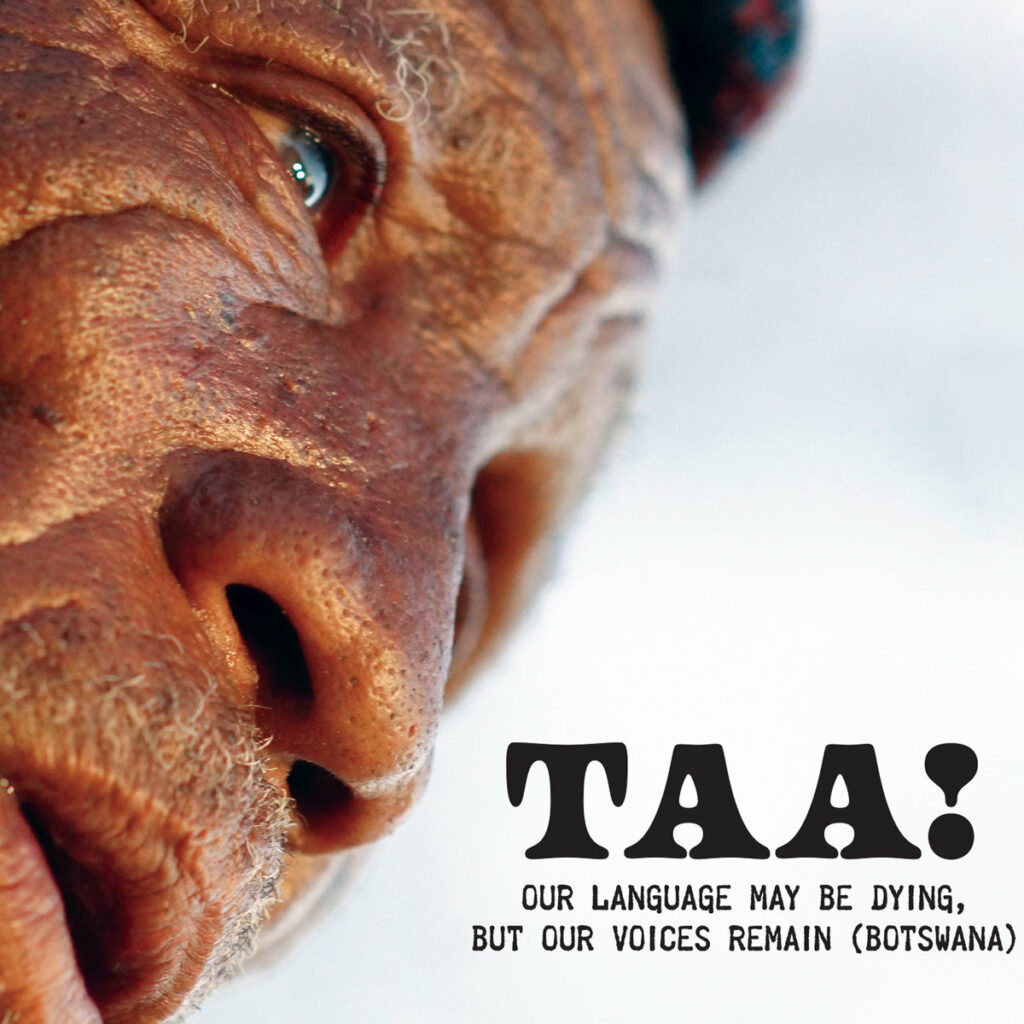Taa! Our language may be dying, but our voices remain is een bijzonder album met veldopnames, gemaakt door Ian Brennan in Botswana, gezongen in de Taa-taal
English version below
De afgelopen decennia waren er vele etnomusicologen die veldopnames maakten. De componisten Zoltán Kodaly en Bela Bartok trokken Hongarije door om lokale melodieën op te nemen, te noteren en te verwerken in hun muziek. Hetzelfde gebeurde in Armenië door Komitas Vardapet. Alan Lomax was te vinden in Amerika waar hij lokale liedjes vastlegde op zijn taperecorder, Deben Bhattacharya deed iets soortgelijks in India en Michael Baird kwamen we tegen in Zambia, waar hij de lokale muziek opnam.
Muziek producer Ian Brennan ging naar Botswana om de Taa-taal vast te leggen van de lokale bevolking in verschillende dorpen. Hij werd verwelkomd door de sjamanen die liederen voor hem zongen. Taa is een taal met 112 klanken (de meeste ter wereld – westerse talen hebben er ‘maar’ rond de 40). Er leven nog maar zo’n 2500 native Taa-sprekers, dus het is de hoogste tijd op deze opnames te maken.
De opgenomen stukken op het album Taa! Our language may be dying, but our voices remain zijn mantra’s, of gezongen gebeden, met herhalende zinnen/melodieën. De liederen bestaan uit solo-stem, al dan niet aangevuld met handgeklap, (gevonden) percussie en duimpiano (mbira)-begeleiding. Een instrument dat we ook tegenkomen in buurland Zimbabwe. De opnames zijn vrij kort maar geven een sympathieke inkijk in het (religieuze) leven van de bevolking. Innemend is het openings trance-lied door de 81-jarige Gonxlae met duimpiano-begeleiding, of het lied We must Give Thanks, met plastic-beker-percussie en klik-klanken in de melodie. In het lied Prayer for Food horen we naast de duimpiano ook de fluisterzang met licht ademfluiten. Our Ancestors show the Way valt op door de op-de-tel-zang van de 29-jarige vrouw Ntebogang, aangevuld met licht metalen percussie. Euforie klinkt er in My Culture is the Most Beautiful waar Kasigo (22) wordt begeleid door vibrerend handgeklap. De 69-jarige Duxwa sluit het album af met helende muziek in Preparation to Heal met twinkelende duimpiano.
In deze met-liefde-opgenomen-CD Taa! Our language may be dying, but our voices remain word je ontvoerd naar het alledaagse en religieuze leven in Botswana. Het album leidt tot enige bezinning, respect en (her)waardering van de rijkdom in onze unieke wereld waar, mede door economische globalisering, weer een cultuur lijkt te verdwijnen.
English version
Taa! Our language may be dying, but our voices remain is a special album with field recordings from by Ian Brennan in Botswana, sung in the Taa language
In recent decades, many ethnomusicologists have made field recordings. The composers Zoltán Kodaly and Bela Bartok traveled through Hungary to record, notate and incorporate local melodies into their music. The same happened in Armenia by Komitas Vardapet. Alan Lomax could be found in America where he recorded local songs on his tape recorder, Deben Bhattacharya did something similar in India and we met Michael Baird in Zambia, where he recorded local music.
Music producer Ian Brennan went to Botswana to record the Taa language from the local people in different villages. He was welcomed by the shamans who sang songs to him. Taa is a language with 112 different sounds (most of the Western languages have ‘only’ 40). There are about 2,500 native Taa speakers left, so it’s about time to make these recordings!
Most of the recorded pieces on the album Taa! Our language may be dying, but our voices remain are mantras, or sung prayers, with repeating sentences/melodies. The songs consist of solo voice, whether or not supplemented with handclaps, (found) percussion and thumb piano (mbira) accompaniment. An instrument that we also encounter in neighboring Zimbabwe. The recordings are quite short but provide a sympathetic insight into the (religious) life of the population. Charming is the opening trance song by 81-year-old Gonxlae with thumb piano accompaniment, or the song We must Give Thanks, with plastic cup percussion and click sounds in the melody. In the song Prayer for Food, in addition to the thumb piano, we also hear the whispering vocals with light breath whistles. Our Ancestors show the Way stands out because of the on-the-count vocals of the 29-year-old woman Ntebogang, supplemented with light metal percussion. Euphoria can be heard in My Culture is the Most Beautiful, where Kasigo (22) is accompanied by vibrating hand clapping. The 69-year-old Duxwa closes this wonderful album with healing music in Preparation to Heal with twinkling thumb piano.
On this with enthousiasme recorded CD Taa! Our language may be dying, but our voices remain you are invited to everyday and religious life in Botswana. The album leads to some reflection, respect and (re) appreciation of the wealth in our unique world where, partly due to economic globalization, another culture seems to be disappearing.
*Taa! Our language may be dying, but our voices remain (Glitter Beat / Xango)
© Mattie Poels.


Geen reacties